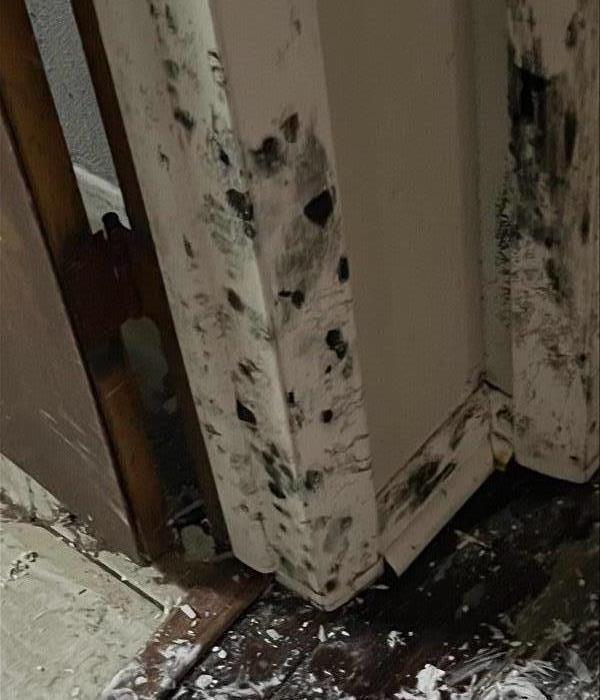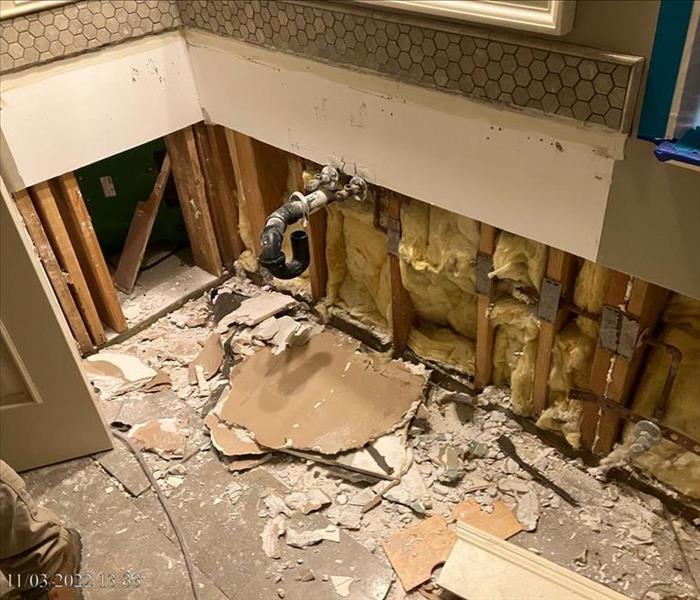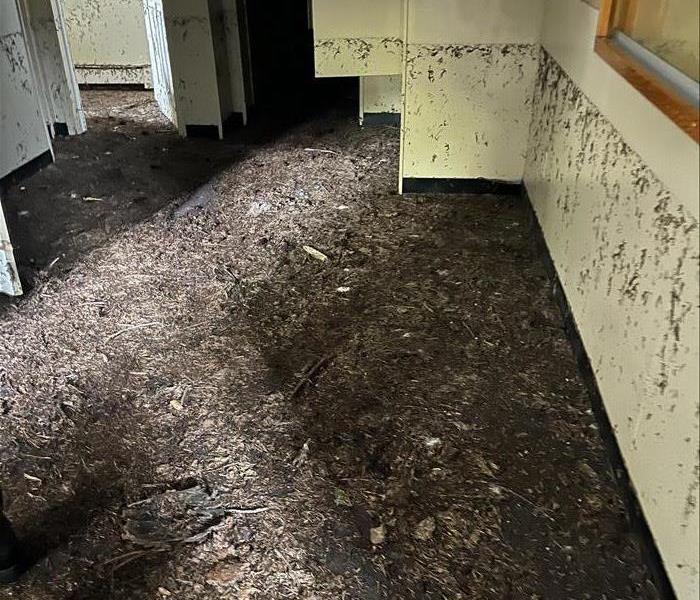Recent Mold Remediation Posts
Tenant and Landlord Responsibilities for Mold Prevention in Rental Properties
11/15/2024 (Permalink)
Mold is a common issue in rental properties, often caused by moisture and inadequate ventilation. When mold appears, it’s important to address it quickly to prevent damage and ensure a safe living environment. Both tenants and landlords play a role in preventing and managing mold growth, and understanding these responsibilities can help keep the property safe and well-maintained.
Tenant Responsibilities
Tenants play a significant role in preventing mold by maintaining a clean and well-ventilated living space. While landlords are responsible for structural issues, tenants need to take everyday precautions to avoid creating an environment where mold can thrive.
- Report Water Damage Promptly: Mold thrives in damp areas, often caused by leaks or water damage. If a tenant notices any leaks, condensation, or damp areas in the property, they should immediately notify the landlord. This helps prevent mold from taking root in areas like ceilings, walls, or floors.
- Proper Ventilation: Tenants should ensure that areas prone to moisture, such as bathrooms and kitchens, are properly ventilated. This can be as simple as using exhaust fans, opening windows, or wiping down damp surfaces to reduce humidity levels in these spaces.
- Regular Cleaning: Keeping areas like bathrooms, kitchens, and laundry rooms clean and dry is essential in preventing mold. Mold can grow on various surfaces, including tile, wood, and fabric, if left unchecked. Tenants should also keep furniture away from walls to promote airflow and reduce condensation buildup.
- Avoid Overwatering Indoor Plants: Mold can develop in damp soil, which can spread to nearby areas in the home. Tenants should be cautious when watering indoor plants and ensure that water doesn’t pool on floors or furniture.
Landlord Responsibilities
Landlords have a legal obligation to provide a habitable living space, which includes addressing mold issues that stem from structural problems, leaks, or poor maintenance. Failing to address mold problems can lead to property damage, tenant dissatisfaction, or even legal action.
- Respond to Maintenance Requests Quickly: If a tenant reports a water leak, condensation, or signs of mold, landlords must respond promptly. Ignoring these issues can lead to further damage.
- Maintain Building Structures: Mold growth often occurs due to faulty structures, such as leaky roofs, damaged plumbing, or poor ventilation systems. Landlords should regularly inspect and maintain the property to prevent moisture from seeping into walls, ceilings, or floors.
- Professional Mold Remediation: If mold becomes a serious issue, landlords should seek the services of professionals like SERVPRO®. Attempting to handle mold without the proper equipment or expertise can result in incomplete removal or the spread of spores to other areas. SERVPRO provides thorough mold remediation services, ensuring that the problem is fully addressed and doesn’t return.
- Install Proper Ventilation: Landlords can help prevent mold by ensuring that bathrooms, kitchens, and laundry areas are properly ventilated. Installing exhaust fans or making sure windows can open will help tenants manage moisture levels.
Working Together to Prevent Mold
Mold prevention is a shared responsibility. Tenants should practice good cleaning habits and promptly report any signs of water damage or mold, while landlords need to act quickly and ensure that the property is well-maintained. Working together not only prevents mold but also ensures a positive tenant-landlord relationship.
When mold does appear, it’s essential to act quickly and involve professionals like SERVPRO of Marina Del Rey/Westchester/El Segundo. With advanced mold remediation techniques, SERVPRO can safely remove mold from rental properties and help identify any underlying moisture problems. By addressing the issue at its source, SERVPRO ensures that mold is eliminated and prevented from returning, protecting both the property and its occupants.
Understanding the Connection Between Water Damage and Mold
7/17/2024 (Permalink)
 Understanding the link between water damage and mold is crucial for homeowners.
Understanding the link between water damage and mold is crucial for homeowners.
Water damage and mold often go hand in hand. When water infiltrates your home, it creates the perfect environment for mold growth. Understanding this link can help you take proactive steps to prevent mold after experiencing water damage. In this blog, we will discuss how water damage leads to mold growth, the importance of quick action, and tips to prevent mold development.
How Water Damage Leads to Mold Growth
Mold thrives in damp, humid environments. When water damage occurs, whether from a burst pipe, flooding, or a leaking roof, it introduces moisture into your home. Here’s how this process unfolds:
- Moisture Accumulation
When water enters your home, it seeps into porous materials like wood, drywall, and carpeting. These materials absorb water, creating a moist environment that is ideal for mold spores to settle and grow. Moisture accumulation is the first and most crucial step in mold formation. If left unchecked, these damp materials can support extensive mold colonies.
- Humidity Increase
Water damage often leads to increased humidity levels in your home. High humidity creates condensation on surfaces, adding to the moisture content. Mold needs only 24-48 hours to start growing in such conditions. Even small increases in humidity can create a conducive environment for mold, particularly in enclosed spaces like basements, attics, and behind walls.
- Lack of Ventilation
Water-damaged areas often suffer from poor ventilation. Stagnant air prevents moisture from evaporating, allowing mold to take hold and spread. Proper ventilation is key to drying out water-damaged areas and preventing mold growth. Without adequate airflow, damp areas remain wet for longer periods, allowing mold spores to grow and spread.
- Temperature Conditions
Mold grows best in warm temperatures, typically between 77°F and 86°F (25°C to 30°C), but it can grow in a wide range of temperatures. After water damage, if the temperature in your home is within this range, mold growth can accelerate. Controlling indoor temperatures can be a crucial factor in mitigating mold risk.
- Time Factor
Mold can begin to grow within 24-48 hours after water damage occurs. The longer the water remains, the more extensive the mold growth can become. Immediate action is crucial to prevent mold from taking hold. Quick drying and dehumidifying are essential to reduce the window of opportunity for mold growth.
- Organic Materials
Homes are filled with organic materials that mold can feed on, such as wood, paper, and certain types of insulation. When these materials get wet, they provide the nutrients mold needs to thrive. Ensuring these materials are dried thoroughly and quickly is vital in preventing mold proliferation.
The Importance of Quick Action
Quick action is crucial when dealing with water damage. The longer the water sits, the more likely mold will develop. Here are some reasons why an immediate response is essential:
- Preventing Mold Growth: Acting quickly can prevent mold spores from germinating. Drying out the affected areas within 24-48 hours significantly reduces the chance of mold growth.
- Reducing Damage: Prompt water removal and drying help minimize damage to your property. The less damage there is, the easier and cheaper it is to repair.
- Preserving Structural Integrity: Mold can compromise the integrity of your home’s structure, leading to costly repairs and safety hazards. Quick action ensures your home remains safe and structurally sound.
Understanding the link between water damage and mold is crucial for homeowners. Quick action and effective preventive measures can make a significant difference in preventing mold growth after water damage. If you experience water damage, acting quickly to remove water, dry affected areas, and monitor humidity levels can help keep your home mold-free. For severe water damage or mold issues, consider contacting a professional service like SERVPRO of Marina Del Rey/Westchester/El Segundo for expert assistance. Taking these steps ensures a safer, more comfortable living environment and protects your property from further damage.
Mold in Crawl Spaces: Prevention and Remediation
3/13/2024 (Permalink)
 We will explore the reasons behind mold in crawl spaces and provide tips on how to remediate and prevent mold effectively.
We will explore the reasons behind mold in crawl spaces and provide tips on how to remediate and prevent mold effectively.
Having mold in your crawl space can be a common and concerning issue for homeowners. While mold growth poses potential risks to your property, it is important to understand the causes and effective prevention and remediation strategies for tackling mold in crawl spaces. In this blog, we will explore the reasons behind mold in crawl spaces and provide tips on how to remediate and prevent mold effectively.
Causes of Mold in Crawl Spaces
Crawl spaces offer a perfect environment for mold growth due to various contributing factors. Understanding these causes will help you prevent mold in your crawl space. Here are some common causes:
- Moisture: Excess moisture is the primary culprit behind mold growth in crawl spaces. Moisture can enter crawl spaces through the ground, foundation cracks or leaks, plumbing issues, or inadequate drainage. Once moisture accumulates in the space, it promotes the growth of mold.
- Poor Ventilation: Inadequate ventilation in crawl spaces hampers airflow, allowing moisture and humidity to build up. The lack of proper airflow creates a damp environment that is conducive to mold growth.
- Insufficient Insulation: Improper or insufficient insulation can lead to condensation in crawl spaces. If warm, humid air comes into contact with cooler crawl space surfaces, condensation occurs, providing the ideal conditions for mold growth.
Remediation of Mold in Crawl Spaces
If you discover mold in your crawl space, taking immediate remediation measures is essential to prevent further damage. Follow these effective strategies:
- Identify and Fix the Source of Moisture: Start by identifying and resolving the source of moisture in your crawl space. Look for plumbing leaks, foundation cracks, or other areas where water may be entering. Fixing these issues is crucial to prevent recurring mold growth.
- Improve Ventilation: Enhancing ventilation is vital in reducing moisture levels. Consider installing vents or fans to promote air circulation in your crawl space. Ventilation can help remove excess moisture and prevent mold growth.
- Remove Mold-Infested Materials: If there are porous materials in your crawl space that have been extensively affected by mold, such as insulation or wooden beams, it may be necessary to remove and replace them to eliminate the mold thoroughly.
- Clean and Disinfect: Using a mold cleaner recommended for use in crawl spaces, scrub the affected areas thoroughly to remove visible mold growth. Ensure that you clean both the surfaces and the surrounding area to prevent further contamination.
- Encapsulate the Crawl Space: Encapsulation involves sealing the crawl space with a moisture-resistant barrier to prevent moisture intrusion. This method can help control humidity levels and prevent future mold growth.
Prevention of Mold in Crawl Spaces
Prevention is key to avoiding mold in your crawl space. Here are some preventive measures:
- Install Vapor Barriers: Lay down vapor barriers on the ground to prevent moisture from seeping into your crawl space. These barriers act as a protective layer between the ground and your crawl space, reducing the potential for mold growth.
- Maintain Proper Drainage: Ensure that your gutters are directing water away from your foundation. Regularly check and clean your drains to prevent any blockages that may cause water to pool around your crawl space.
- Monitor Humidity Levels: Consider installing a dehumidifier in your crawl space to maintain humidity levels below 50 percent. Monitoring and controlling humidity significantly reduce the chances of mold growth.
- Regular Inspections: Schedule regular inspections of your crawl space to catch any potential issues such as leaks or condensation before they escalate. Promptly addressing these issues can prevent mold growth.
Understanding the causes, remediation, and prevention strategies is crucial when dealing with mold in crawl spaces. By addressing moisture sources, improving ventilation, and implementing preventive measures, you can effectively remediate existing mold and prevent its recurrence. Regular maintenance, inspections, and vigilance will help ensure a clean and mold-free environment in your crawl space.
Uncovering the Truth: Does Your Commercial Insurance Policy Cover Mold Damage?
6/8/2023 (Permalink)
Mold damage is the result of mold infestation. Mold spores are microscopic, but Mold can spread quickly. When you see or smell mold, it's important to take action before the problem gets worse. If you have a commercial insurance policy that covers mold damage and your property has been affected by it, then you may be able to get reimbursed for any repairs or replacements that were necessary after the incident occurred.
What Does Commercial Insurance Cover?
Commercial insurance policies come in a variety of types, but they all share the same basic coverage for mold damage. The following are some common commercial insurance policies:
- Business owners policy (BOP)
- Commercial property policy (CPP)
- General liability insurance (GL)
- Workers compensation insurance (WCI)
How Do I File a Claim for Mold Damage?
To file a claim for mold damage, you will need to document the damage and estimate the cost of repair. You can use this information to help you file your insurance claim.
Once your home has been cleaned up and repaired, be sure to take pictures of the area before repairs are made so that you have a record of what it looked like before any work was done. If there were any items damaged by water or mold (such as furniture), take photos of those items as well so that they can be replaced with new ones by your insurance company if necessary.
The next step is estimating how much money it will cost to repair all of these damages--and this might include more than just replacing damaged property with new items: if there were structural issues related directly with mold growth (such as cracking walls), then those costs may also need factored into determining how much money should be reimbursed by an insurer once they've reviewed all available documentation provided by homeowners who filed claims against them following such incidents occurring within their homes' walls.
How Can I Avoid Mold Damage?
When it comes to preventing mold damage, there are a few things you can do. First, maintain proper humidity levels in your building by using a dehumidifier or air conditioner if necessary. Second, regularly inspect for signs of mold and fix any water damage quickly. If you have an area in your building where moisture is an issue (such as near plumbing), consider installing a ventilation system that will help keep the air dryer and less hospitable to mold growth.
What Should I Do If I Have a Mold Problem?
If you think you have a mold problem, the first thing to do is hire a professional mold removal service. These companies have trained technicians who can identify and remove all traces of mold from your property. They'll also make sure that their work is done safely and according to industry standards.
Mold is a serious problem that can cause significant damage to your business. If you have any questions about mold insurance and how it works, contact SERVPRO® today!
How is Mold Identified?
1/19/2023 (Permalink)
Mold is a living organism, so it adapts to its environment. Even if you have seen mold before, it may be different every time because it has grown into different shapes, sizes, and colors. The best way to identify the type of mold in your home is to contact an experienced professional who can inspect your home and determine what type of species are growing there as well as what kind of remediation process will be needed.
Mold Identification is a Complex Subject
It can be difficult to identify mold. This article will explain the basics of mold growth, how to spot it and whether you need to treat your home.
Mold can be found in many places around your home, particularly if there’s been water damage or flooding. While most people think of mold as being black or greenish-black, it can also appear as dark brown or grayish-white. It's important not to confuse molds with other types of fungus that may be growing in your home too – these might look similar but aren't harmful like true molds are!
Why is Mold Identification Important?
The first and most important reason to identify mold is that it can cause extensive damage to your property and belongings. Mold growth can eat through a variety of materials, including wood, drywall, and even furniture. If you find that there is mold on your property, it’s best to act quickly and remove the source of moisture before it spreads further.
Mold identification is also important because it can be expensive! Often times people will try to remove mold themselves in their homes or businesses without knowing exactly what they are doing which can cause additional damage and lead them down a rabbit hole of cost. While this isn’t always true, most times, hiring professionals with experience working with this kind of material is worth every penny you spend on them!
Professional Mold Inspection and Identification
Mold inspectors are trained and experienced in identifying mold. They will use a variety of tools to identify the presence of mold, including microscopes to see visible mold spores on surfaces or in air samples. Moisture meters can be used to measure moisture content in building materials, like wood or drywall. Air quality testing can also help identify if there is an elevated level of mold spores in your home’s air that may not be visible to the naked eye.
The most important thing to remember when trying to identify mold is that there are many kinds of mold and each one has its own set of characteristics. Most people can learn how to identify some types of mold but it takes years of experience with the subject matter before someone can say they know what they’re doing. If you have an issue with mold in your home or business, then call a professional!

 24/7 Emergency Service
24/7 Emergency Service


